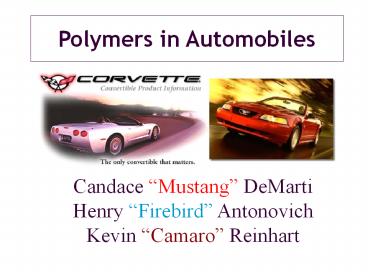Polymers in Automobiles - PowerPoint PPT Presentation
Title:
Polymers in Automobiles
Description:
ULTEM polyetherimide (PEI) resin to replace aluminum under the hood for 1st time ... Plastic Body Panels - Chevy Corvette since 1953 ... – PowerPoint PPT presentation
Number of Views:1326
Avg rating:3.0/5.0
Title: Polymers in Automobiles
1
Polymers in Automobiles
Candace Mustang DeMartiHenry Firebird
AntonovichKevin Camaro Reinhart
2
Overview
- Plastics vs. Metals
- Polymer Applications in Automobiles- Instrument
Panels- Engine- Windows- Tires- Body Panels
3
Why use plastics?
- Oil Embargo (1970s) and Japanese Competition
- Compete with other materials based on
- Weight savings
- Design flexibility
- Parts consolidation
- Ease of fabrication
4
Show Tell
5
(No Transcript)
6
Instrument Panels (IP)
- Polycarbonate/ABS resins
- Introduction of airbags in IP design
- Injection Molding vs. Blow Molding
7
Instrument Panels (IP)
8
Engine
- ULTEM polyetherimide (PEI) resin to replace
aluminum under the hood for 1st time
- High-performance amorphous
resin from GE - Complete air management modules can be made
of thermoplastic
Throttle Body
9
Body Panels
- Plastic Body Panels - Chevy Corvette since 1953
Sheet Steel - still most commonly used for
vehicle body structure Aluminum - weighs less
but costs more Plastics - increasingly used for
metals parts replacement
10
Choosing a material
- 1. Cost
- 2. Flexural Modulus
- 3. Coefficient of Thermal Expansion
- 4. Chemical Resistance
- 5. Impact Resistance
- 6. Heat Deflection Temperature (HDT)
11
- On-line vs. Off-line painting
- Better color match
- Incorporate in existing facilities
- Assembly line temperatures exceed 200oC Alloys
- Polyphenylene ether/polyamide ABS/Polyesters
- ABS/Polycarbonates
- Larger choice in materials
- Additional steps take time
- More plastics will enter the market as assembly
lines are redesigned
12
Sheet Molding Compound (SMC)
- Highly cross-linked and highly filled
- Polymer component is polyester
- Suitable of compression molding
- Molded product combined high modulus with high
strength - Body panels (hoods and deck lids)
- More expensive than metal, but lower tooling cost
13
Applications of SMC
- Bottom line benefits
- Tooling for SMC hood was 23 of steel
- Weight savings of 18
- Growth of applications
- - Body panels on GMs Lumina, TransPort, and
Silhouette - - Structural components - valve covers, grille-
opening reinforcements, fascia supports, etc.
- 250 million lbs. of SMC was used in 1997
14
Applications of SMC
- Composite front fenders and hood design for 1995
Lincoln Continental - Result of need for lighter-weight and more cost
efficiency integrated system - SMC fenders and hood
- Bottom line benefits
- SMC fender tooling was 40 of projected tooling
for steel fenders - Comparative weight saving was 33
15
Solitary Bumper Beam
- For 1997 Saturn coupe
- Injection molded from GE Plastics Xenoy 1102
- Single part that replaces functions of 17 parts
on previous system - To absorb impact, specially designed molded-in
towers crush upon impact
16
Windshields
- Toughened Safety Glass (TSG)- tempered glass
- Laminated Safety Glass (LSG)- two panes of glass
bonded together using polyvinylbutyral
17
Tire Components
- Tread
- Sidewall
- Bead-high tensile brass-plated steel coated with
rubber - Radial Ply-belts of rubber coated cord
- Innerliner
- Reinforcing Fillers-carbon black
- Chemicals-antidegradants, curitives
18
Desirable Properties of Tire Components
19
Elastomers in Tires
- Natural Rubber (NR)
- Polyisoprene Rubber (IR)
- Styrene Butadiene Rubber (SBR) - 1.89
billion lbs/yr (1993) - Polybutadiene Rubber (BR) -
1.03 billion lbs/yr (1993)
20
Natural Rubber (NR)
- 99.99 cis Polyisoprene
- Good low temperature flexibility.
- Low Tg (-65 C). Low heat buildup.
- 200,000 to 400,000 MW. Easy Processing.
- Has high tensile and tear properties. Stress
crystallizes. - Excellent dynamic fatigue
- Poor resistance to oxygen, ozone, hydrocarbon
solvents and heat.
21
Polyisoprene Rubber (IR)
- Same cis structure as NR, but also contains low
levels of 3,4 and trans 1,4 polyisoprene. - Above structures prevent stress crystallization
and thus has lower tensile and tear properties. - 300,000 to 500,000 MW.
- Other properties similar to NR .
22
Polybutadiene Rubber (BR)
- Good low temperature flexibility.
- High abrasion resistance.
- Low heat buildup.
- Low tensile strength. Generally blended with SBR
or NR. - Improves aging resistance of NR.
23
Styrene Butadiene Rubber
(SBR)
- Dynamic properties determined by styrene, 1,4 and
1,2 butadiene levels. - Improved strength, abrasion resistance, and
blend compatibility over BR alone. - Addition of styrene results in lower cost and
contributes to the good wearing and bonding
characteristics.
24
Elastomers Used in Tire Components

